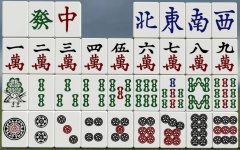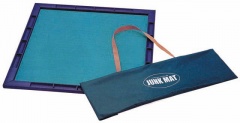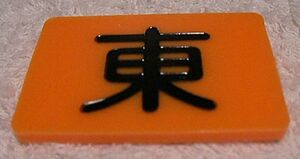Mahjong equipment: Difference between revisions
(→Tenbou) |
|||
| Line 57: | Line 57: | ||
==Tenbou== | ==Tenbou== | ||
{{main|Tenbou}} | |||
'''Tenbou''' {{kana|点棒}} are the '''point sticks''' used to keep track of scores. In a sense, these sticks may be viewed as the game's "currency". When points are exchanged between players, they may either give exact values or give values while requiring some change. Some gambling games may actually tie these point sticks to money. | '''Tenbou''' {{kana|点棒}} are the '''point sticks''' used to keep track of scores. In a sense, these sticks may be viewed as the game's "currency". When points are exchanged between players, they may either give exact values or give values while requiring some change. Some gambling games may actually tie these point sticks to money. | ||
==Chips== | ==Chips== | ||
Revision as of 03:37, 8 March 2019
Of course, the proper equipment is needed in order to play Japanese mahjong. Naturally, mahjong tiles are used. It is possible to play the game using printed cards; yet, it is actually cumbersome to do so. In practice, tiles have been the most effective way to play the game in person.
The game is also available online, video games, and software.
Japanese tiles
Japanese mahjong sets usually come with 144 tiles in a case. For every tile, there is four of each type. Usually, every tile is dual colored, with every tile having the same colored back side; and these colors vary from one set to another. Some sets come with tiles whose front and back side are of the same color. Even then, a specialized set called a "Washizu set" features 3 out of 4 tiles using transparent acrylic material.
For Japanese mahjong, 136 out of 144 tiles are used. The extra tiles are four red five dora tiles: one for manzu and souzu, and two for pinzu. To use these tiles, regular five tiles are switched with the red dora. The remaining four tiles are four flower tiles, which are not used at all. Typically, Japanese tiles are individually about the size 16 mm x 19 mm x 26 mm (WLH). Like most mahjong tile sets, these tiles are capable of standing on their own.
The tiles may be subgrouped in a couple different ways. The first distinction is the separation by suits and tile types. Three groups of tiles form the numbered suits, while another group form the honor tiles, which can be further subdivided as dragons and winds. Within the numbered suits, the tiles numbered 2 through 8 are composed of the simples, while the 1's and 9's are separated as the terminals.
All tiles listed here follow the order used for dora.

Man
| Ii wan | Ryan wan | San wan | Suu wan | Uu wan | Rou wan | Chii wan | Paa wan | Kyuu wan |
Manzu 「萬子」, or man/wan 「萬」 for short, composes the character tiles. The Chinese characters or Japanese kanji are used to indicate the numbers 1-9. While some sets have the alphanumeric representations of the numbers superscript on the upper right corners, it is actually best to remember the kanji for 1-9. Standard Japanese sets lack these alphanumeric superscripts. The character for man means "ten thousand". [1]
Pin
| Ii pin | Ryan pin | San pin | Suu pin | Uu pin | Rou pin | Chii pin | Paa pin | Kyuu pin |
Pinzu 「筒子」, or pin 「筒」 for short, composes the coin or circle tiles. The symbols represent the use of coins.
Sou
| Ii sou | Ryan sou | San sou | Suu sou | Uu sou | Rou sou | Chii sou | Paa sou | Kyuu sou |
Souzu 「索子」, or sou 「索」, composes the bamboo or stick tiles. Ordered 1-9, it is special to note the 1-sou tile which is marked with a large bird instead of 1-stick to discourage cheating by tile alteration.
Kazehai
| Ton | Nan | Shaa | Pei |
Kazehai 「風牌」 are the wind tiles. They are indicated as East, South, West, and North. The wind tiles correlate to the player seating, and so therefore, it is best to remember the wind tiles in the East, South, West, and North order, as they correspond to the seating order. Likewise, this is significant to note for yakuhai.
Sangenpai
| Haku | Hatsu | Chun |
Sangenpai 「三元牌」 are the dragon tiles. They are known as the dragons: white, green, and red. Just noting their color is sufficient enough here.
Mats

Mahjong mats are materials used to provide mahjong tiles a softer surface to slide all over. Naturally, the intent is to prevent or minimize the effect of friction onto the mahjong tiles. After prolonged play, the tiles may eventually wear themselves out and no longer be deemed usable.
Mats come in various sizes, but they're all square shaped. Junk mats provide a plastic perimeter with slots for point sticks.
Tenbou
Tenbou 「点棒」 are the point sticks used to keep track of scores. In a sense, these sticks may be viewed as the game's "currency". When points are exchanged between players, they may either give exact values or give values while requiring some change. Some gambling games may actually tie these point sticks to money.
Chips
Round indicator

A dealer marker is used throughout the game to either indicate the current dealer, or the initial dealer. In the case of the latter, the dice are used to indicate the current dealer, as it gets passed around from one dealer to the next. It is also used to indicate the current round, either the East Round or South Round.
Automatic tables
Automatic mahjong tables are used to expedite the process of tile shuffling and wall building. With the push of a button, players can save time as the wall building process is performed by machine.